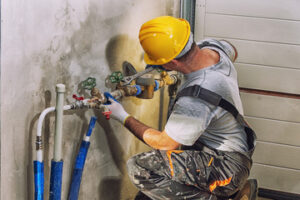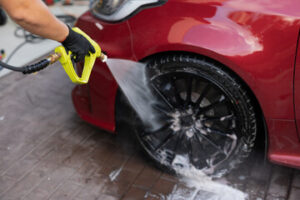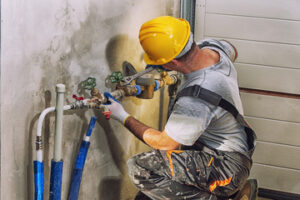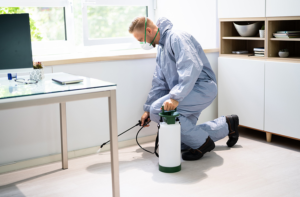Using the right type of pesticide for each situation helps keep pest populations below threshold levels and reduces the risk to humans and pets.
Natural barriers, such as mountains and large bodies of water, limit the spread of some pests. Natural enemies and the availability of food and shelter help control others. Contact Springfield MO Pest Control now!

Pests invade your home or business and can damage structures and disrupt your daily routine. Proper pest control measures can help you ward off unwanted critters, saving you money and preserving your property.
Prevention is usually the first step in controlling pests, as it involves taking steps to eliminate conducive conditions that attract them. These include sources of food, water, and shelter. Leftover food and crumbs, trash cans without covers, cracks in walls and open doors all provide inviting habitats for pests. Regularly clean counter tops, wipe down surfaces and store foods in sealed containers. Remove garbage on a regular basis and keep outside garbage cans tightly closed. Fix leaky faucets and plumbing, and don’t leave standing water or dishes on the kitchen sink or countertops.
The best way to prevent pest infestation is to learn about the specific pests you have and what options are available for their control. Avoid the temptation to solve your own pest problems with sprays or chemical products. These can cause harm to pets and children, contaminate food and can cling to carpets, clothing and furniture. Always read product labels and follow instructions carefully. Purchase your products from reputable, registered dealers and use them only as directed.
A good pest control program will also include regularly inspecting the interior and exterior of your property for signs of a problem. This will include checking for droppings, gnaw marks and nesting sites. It will also include examining outdoor areas for open or blocked entryways and correcting them. Then, to reduce the appeal of your premises to pests, trim trees and shrubs away from your structure, and store firewood securely.
Pests are most likely to enter homes and businesses when they seek food, water and shelter. This makes prevention a crucial part of pest control. In addition to cleaning regularly, storing food in sealed containers and reducing indoor clutter, pests may enter through open windows and unscreened doors, so it’s important to keep them shut as much as possible and to use screens on all exterior doors. If you have a screen door but don’t have a storm door, consider installing one, as pests can easily crawl through the gap between the bottom of the door and the floor.
Suppression
Pest control must consider the entire system within which the pest exists. This includes living organisms and nonliving surroundings such as the air, water and structures. It also includes the pest’s natural enemies, barriers, food and shelter sources, and other factors that influence population growth and damage. Unless all of these are taken into account, your pest control effort may have unintended effects and cause more harm than the pest itself. This is particularly important if the treatment site is outdoors. It is equally important in indoor spaces where the impact on people, pets and plants must be considered. When using pesticides, be sure to follow the advice on product labels and apply only as directed.
Preventive measures prevent pest infestations from developing. This includes removing conditions that encourage pests, such as overgrown or weedy areas that provide hiding places and food for them. Frequent cleaning of surfaces where pests tend to congregate can also help. For example, dusting or vacuuming can remove crumbs and other food sources that attract cockroaches or mice. Garbage should be disposed of on a regular basis and stored in tightly closed garbage cans to deter rodents.
Some pests are so dangerous to human health and safety or to property that action must be taken to eradicate them, whether they are in a home or commercial setting. In such cases, “action thresholds” are set that define when a pest population should be controlled. In other situations, eradication is done at a more general level.
Mechanical and physical controls kill pests directly or block them from entering or moving around a property. These include traps, screens, barriers, fences, nets and radiation. They can also include altering the environment, such as introducing plants that are resistant to pests or creating collections of items that are kept in ways that discourage them from breeding and thriving, such as by sealing cracks, caulking windows and doors, keeping collections dry and cool and using sweeps and astragals to close gaps under doors.
Biological pest control uses predators, parasites and other natural organisms to suppress pest populations. Examples of this include the use of mites that control mite pests in orchards and nematodes that control harmful soil grubs. This method of pest control is often referred to as integrated biological control.
Eradication
Pests cause damage to crops and property, spread disease, contaminate food and threaten human health. They also interfere with economic activities, as in the case of rats chewing through electrical wires which could result in costly repairs and loss of power. In addition, some pests carry allergens which are known to cause medical problems ranging from mild to severe for humans. Pest control involves managing these problems by using preventive techniques to reduce pest populations and/or controlling them through suppression and eradication.
Termite infestations can cost homeowners thousands of dollars in repair costs, and some even lose their homes. Cockroaches can transmit diseases that require expensive medical attention. A variety of agricultural pests can damage crops and lower yields. Pesticides may be needed to help manage these pests.
A wide variety of methods are available for controlling pests in both outdoor and indoor environments. These are categorized as cultural, biological, chemical or mechanical and can be combined in an integrated pest management program. Cultural techniques include crop rotation, good sanitation, soil conditioning, and the use of beneficial insects or bacteria to reduce pests.
Chemical control includes the use of sprays, fogging devices, baits and traps. It is important to select the most suitable product for the situation and always read and follow label directions and safety warnings. It is also wise to consider less toxic options, such as plant growth regulators, which can reduce the need for more hazardous chemicals.
Biological and mechanical methods are often more effective than chemical controls. For example, rodents can be controlled by introducing natural predators such as cats or dogs into the environment, or by planting flowering plants that repel mice and other rodents. Garden pests can be managed by cultivating beneficial insects such as nematodes or earthworms, which compete with the pests for nutrients in the soil.
In general, eradication is a rare goal in outdoor pest situations, and is only attempted when it is clear that the pests have become established and are spreading rapidly. Such eradication programs have been implemented for the Mediterranean fruit fly, gypsy moth and fire ants.
Biological Control
The goal of biological control is to manipulate natural enemies (predators, parasites, nematodes, and pathogens) to reduce pest numbers. Natural enemies are more effective and safer for humans, the environment and pets than chemical pesticides. Insects, mites and nematodes are commonly used in biological control schemes.
A major advantage of biological control is that it does not create resistance in the pest population as conventional chemical pesticides often do. In addition, biological agents can be released directly into the environment without harming beneficial insects or other organisms.
Biological control methods are most often employed against exotic pests that have been inadvertently introduced from elsewhere, rather than those that are intentionally brought into the environment for commercial purposes or by gardeners who want to get rid of undesirable plants. Biological control involves extensive preliminary studies to develop an in-depth understanding of the pest and its habitat, and of the native organisms that naturally coexist with it. These organisms, referred to as “natural enemies,” are collected in their native habitat and then reared in large numbers for release in the field. These releases are called “classical” or “importation” biological control.
Another type of biological control is referred to as “augmentation” biological control. Augmentation is a technique in which existing natural enemies that occur in the field are increased through changes in landscape management practices. This may include providing food sources for natural enemies, such as leaving patches of a desired plant untreated with herbicide, or creating new habitats where they can flourish, such as digging channels in a saltmarsh to connect pools of water where frogs prey on mosquito larvae.
Another method of boosting natural enemy populations is called “inundative” biological control. This method is similar to the way conventional pesticides are applied, in that it is generally done after a pest outbreak has occurred. Inundative biological control includes releasing a great number of natural enemies (such as bacteria, viruses or fungi) in the area where the pest is found. These natural enemies spread to other areas by spreading their spores, which can be carried on the wind or picked up by insects as they move through the infested area.








